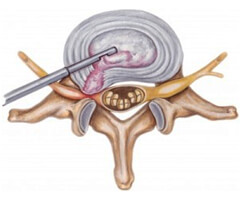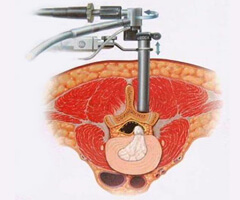Micro Endoscopic Surgery
Introduction to Micro Endoscopic Surgery
 Micro Endoscopic Surgery in the lumbar spine (low back) continues the revolution in the Minimally Invasive Spinal Surgery arena. Micro Endoscopic Discectomy employs all the basic advantages of traditional spinal microsurgery which are listed below
Micro Endoscopic Surgery in the lumbar spine (low back) continues the revolution in the Minimally Invasive Spinal Surgery arena. Micro Endoscopic Discectomy employs all the basic advantages of traditional spinal microsurgery which are listed below
- Illumination and magnification
- Decompression of the affected spinal nerve with direct visualization of the nerve.
The potential advantages are numerous: - Outpatient Surgery
- Less incision pain.
- 14mm, 16mm or 18mm entry via "band aid style" incision with minimal alteration of normal tissue.
- Percutaneous surgery importing the experience derived from traditional spinal microsurgery (the surgeon sees what he/she is doing).
- Faster potential return to work and to routine life activities due to minimal alteration in the normal anatomy.
Before Surgery Precautions
- Stop taking all aspirin and non-steroidal anti-inflammatory medications (e.g. Advil, Naproxsyn, Relafen, etc.) one week before surgery.
- Shower the night before surgery.
- Do not eat after midnight, the night before surgery.
- If you have any questions about other medications, ask your doctor.

Planning your medical trip to India is a very simple process with Spine and Neuro Surgery Hospital India
- You just need to fill in our enquiry form and one of our executive will contact you soon.
- +91-9325887033 Call us at the given to contact number for any assistance.
- Complete information regarding surgery is provided on our website.
Procedure of MicroEndoscopic Surgery
The area where the incision will be made is cleansed and prepped. With the aid of a fluoroscope (a special X-ray), the surgeon passes a thin needle through the skin down to the bone to locate the affected vertebra and disc. In an open discectomy, a skin incision is made down the middle of your back over the affected vertebrae (Fig. 2). The length of the incision depends on how many discectomies will be performed. A single-level incision is about 1 to 2 inches long. The back muscles are retracted on one side to expose the bony vertebra. An X-ray is taken to verify the correct vertebra. In a minimally invasive discectomy, a small incision (less than 1 inch) is made to one side of your back (Fig. 3). Next, a series of progressively larger dilators are passed, one around the other, to gradually separate the muscles and create a tunnel to the bony vertebra. Next, a small opening of the lamina, above and below the spinal nerve, is made with a drill or bone-biting tools (Fig. 4). A laminotomy can be done on one (unilateral) or both (bilateral) sides, or on multiple vertebrae levels. With the lamina removed, the surgeon gently retracts the protective sac of the nerve root. The surgeon looks through a surgical microscope to find the herniated disc. Only the ruptured portion of the disc is removed to decompress the spinal nerve root. The entire disc is not removed (Fig. 5). Bone spurs or synovial cysts that may press on the nerve root are also removed. For a single-level lumbar discectomy, fusion is rarely performed. However, other conditions, such as recurrent disc herniation or spinal instability, may be treated with a fusion. The retractor holding the muscles is removed. The muscle and skin incisions are sewn together with sutures or staples. Steri-Strips are placed across the incision.
After Surgery Precautions
 Use your prescribed pain medication, muscle relaxers, and laxatives as directed.
Use your prescribed pain medication, muscle relaxers, and laxatives as directed.- You have NO stitches to remove. Small bandages ("steri-strips") are on your incision. As these begin to peel off, they can be removed.
- Do not soak in a bathtub for one week after surgery. You can shower after 4 days.
- Do not do any heavy lifting for 2 weeks (i.e. nothing heavier than a carton of milk). After that you can gradually increase your lifting to normal. Most patients can return to completely normal activities in about 3 weeks. Walking is encouraged and bending can be done as tolerated.
- Schedule a return clinic visit for approximately 6 weeks after surgery.
- Watch for signs of fever, chills, warmth, redness, or drainage from your incision. A slight amount is normal for a day or two following surgery
Complications after Surgery
Microendoscopic discectomy (MED) is one of the minimally invasive endoscopic procedures for treating lumbar disc herniation. We have applied MED techniques to posterior decompression procedures for treating lumbar spinal stenosis (LSS). Early postoperative complications occurred in few patients. Some patients experience transient neurological complications. The clinical outcomes at the mean 28-month follow-up were not affected by these surgical complications. Other major complications such as nerve injury and surgical site infection were not observed. The incidence of complications decreased with an increase in the surgeon's experience and the application of several preventive measures against the complications. The surgeon should undergo training when MED techniques are applied in surgical treatment in order to recognize the specific complications associated with such procedures and apply preventive measures against these complications.
Prognosis
Microendoscopic Discectomy (MED) is a safe and effective procedure for the treatment of prolapsed lumbar intervertebral disc. Its results are comparable to standard microdiscectomy. The current indications for this procedure include posterolateral disc herniations and/or lateral recess stenosis.
Want to have a FREE Consultation for your Micro Endoscopic Surgery in India?
We will give you best surgeons for taking best and safe treatments at an affordable low cost. Post a query and get a quick response
Click Here